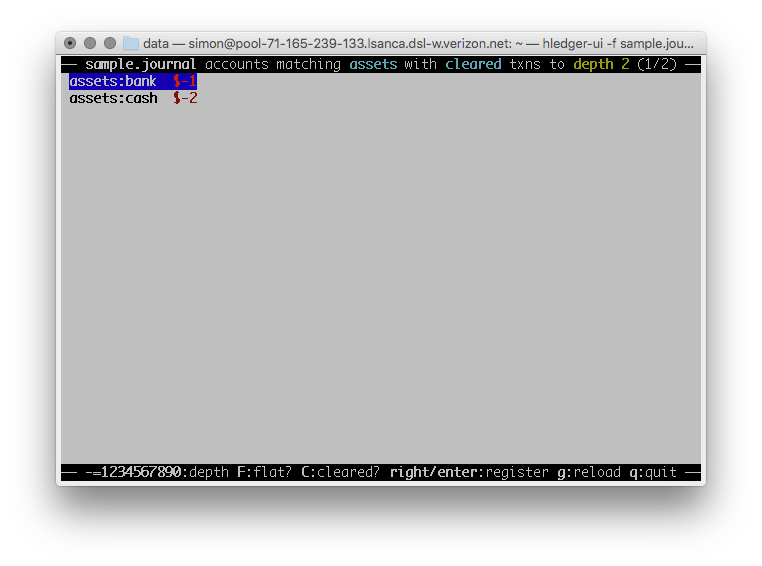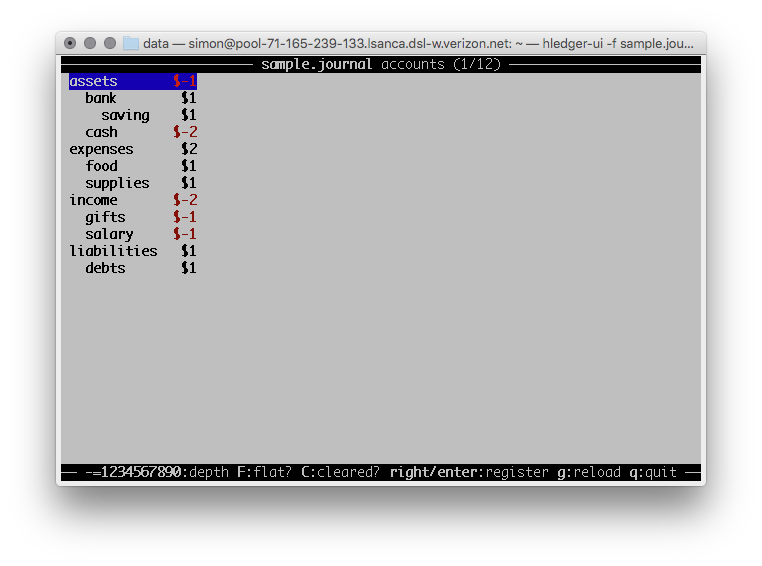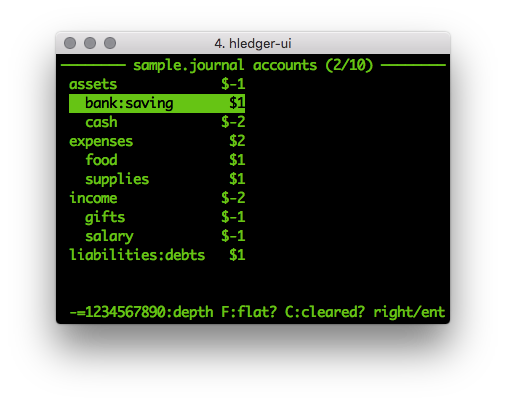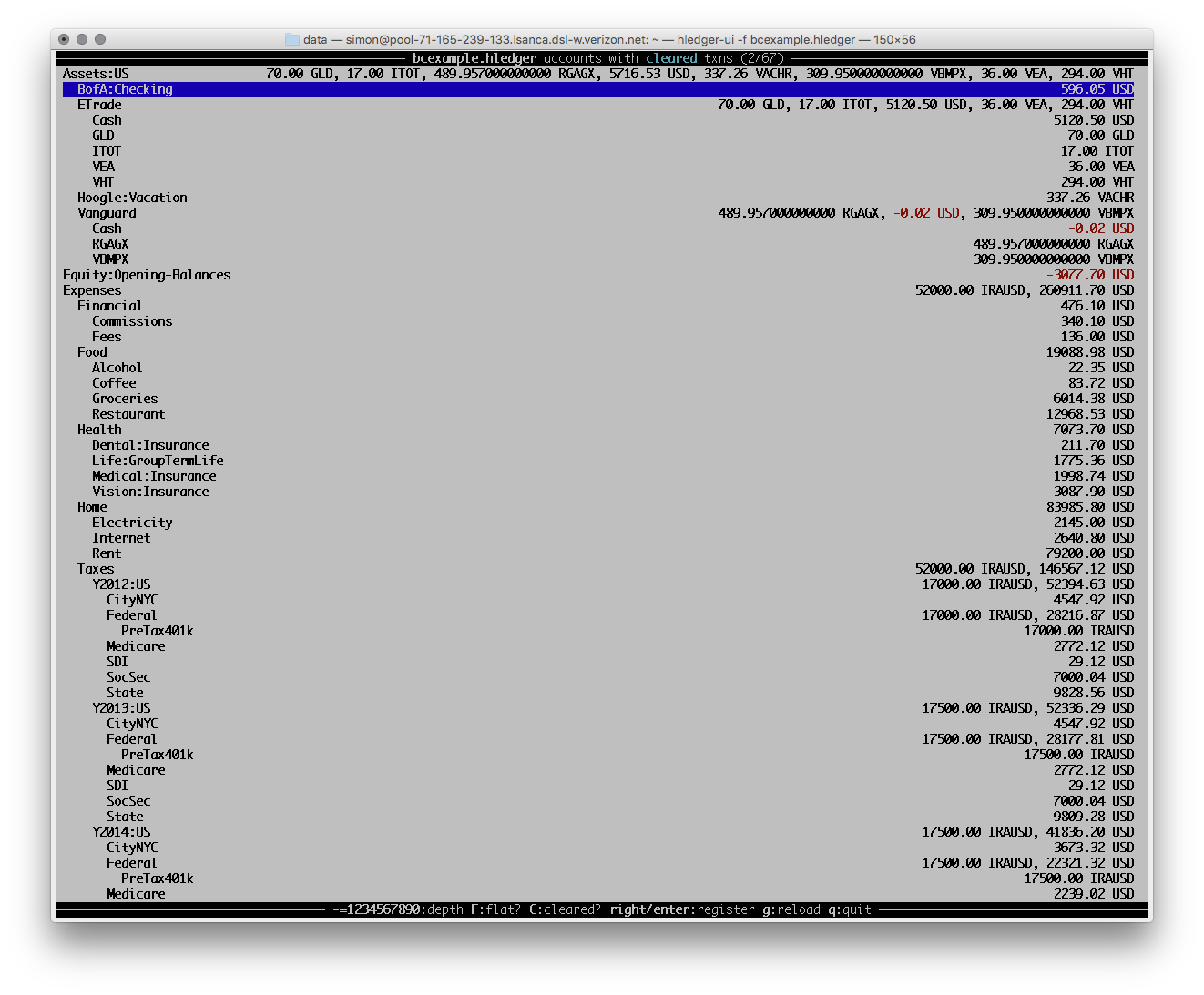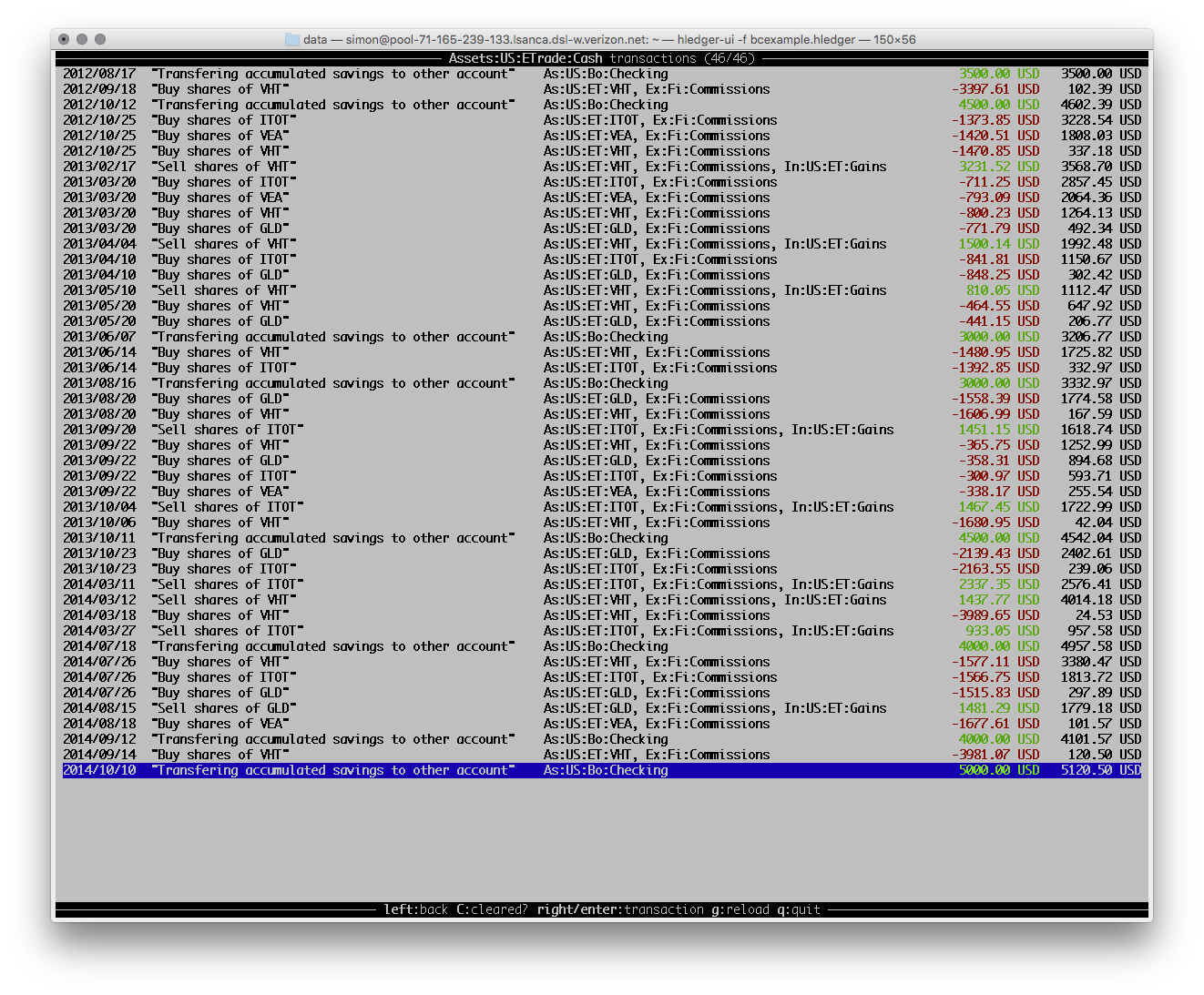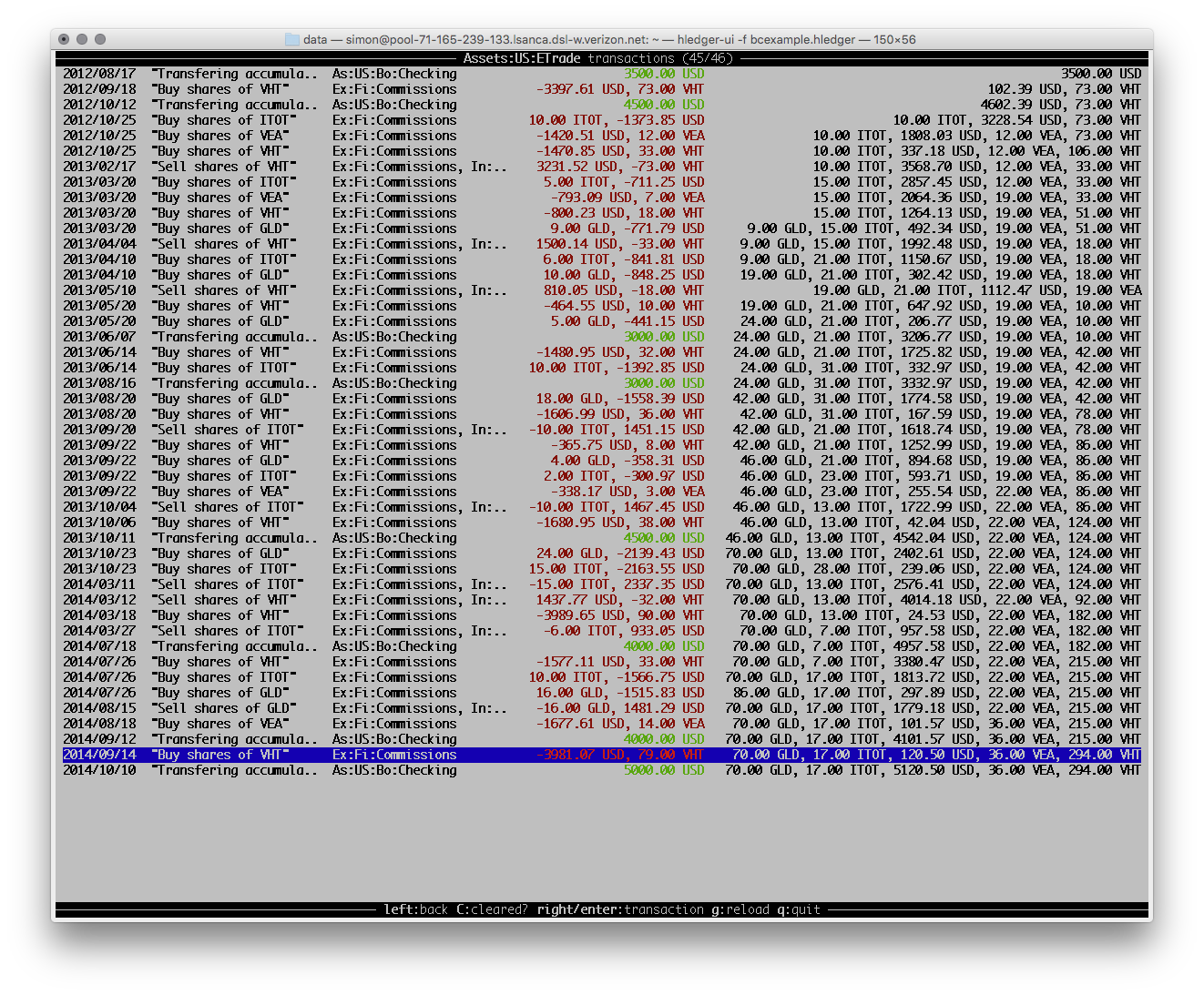hledger-ui
NAME
hledger-ui - robust, friendly plain text accounting (TUI version)
SYNOPSIS
hledger-ui [OPTIONS] [QUERYARGS]
hledger ui -- [OPTIONS] [QUERYARGS]
DESCRIPTION
This manual is for hledger's terminal interface, version 1.29. See also the hledger manual for common concepts and file formats.
hledger is a robust, user-friendly, cross-platform set of programs for tracking money, time, or any other commodity, using double-entry accounting and a simple, editable file format. hledger is inspired by and largely compatible with ledger(1), and largely interconvertible with beancount(1).
hledger-ui is hledger's terminal interface, providing an efficient full-window text UI for viewing accounts and transactions, and some limited data entry capability. It is easier than hledger's command-line interface, and sometimes quicker and more convenient than the web interface.
Like hledger, it reads data from one or more files in journal,
timeclock, timedot, or CSV format. The default file is
.hledger.journal in your home directory; this can be overridden with
one or more -f FILE options, or the LEDGER_FILE environment
variable. For more about this see hledger(1), hledger_journal(5) etc.
Unlike hledger, hledger-ui hides all future-dated transactions by default. They can be revealed, along with any rule-generated periodic transactions, by pressing the F key (or starting with --forecast) to enable "forecast mode".
OPTIONS
Note: if invoking hledger-ui as a hledger subcommand, write -- before
options as shown above.
Any QUERYARGS are interpreted as a hledger search query which filters the data.
-w --watch
: watch for data and date changes and reload automatically
--theme=default|terminal|greenterm
: use this custom display theme
--menu
: start in the menu screen
--all
: start in the all accounts screen
--bs
: start in the balance sheet accounts screen
--is
: start in the income statement accounts screen
--register=ACCTREGEX
: start in the (first) matched account's register screen
--change
: show period balances (changes) at startup instead of historical
balances
-l --flat
: show accounts as a flat list (default)
-t --tree
: show accounts as a tree
hledger input options:
-f FILE --file=FILE
: use a different input file. For stdin, use - (default:
$LEDGER_FILE or $HOME/.hledger.journal)
--rules-file=RULESFILE
: Conversion rules file to use when reading CSV (default: FILE.rules)
--separator=CHAR
: Field separator to expect when reading CSV (default: ',')
--alias=OLD=NEW
: rename accounts named OLD to NEW
--anon
: anonymize accounts and payees
--pivot FIELDNAME
: use some other field or tag for the account name
-I --ignore-assertions
: disable balance assertion checks (note: does not disable balance
assignments)
-s --strict
: do extra error checking (check that all posted accounts are
declared)
hledger reporting options:
-b --begin=DATE
: include postings/txns on or after this date (will be adjusted to
preceding subperiod start when using a report interval)
-e --end=DATE
: include postings/txns before this date (will be adjusted to
following subperiod end when using a report interval)
-D --daily
: multiperiod/multicolumn report by day
-W --weekly
: multiperiod/multicolumn report by week
-M --monthly
: multiperiod/multicolumn report by month
-Q --quarterly
: multiperiod/multicolumn report by quarter
-Y --yearly
: multiperiod/multicolumn report by year
-p --period=PERIODEXP
: set start date, end date, and/or reporting interval all at once
using period expressions syntax
--date2
: match the secondary date instead (see command help for other
effects)
--today=DATE
: override today's date (affects relative smart dates, for
tests/examples)
-U --unmarked
: include only unmarked postings/txns (can combine with -P or -C)
-P --pending
: include only pending postings/txns
-C --cleared
: include only cleared postings/txns
-R --real
: include only non-virtual postings
-NUM --depth=NUM
: hide/aggregate accounts or postings more than NUM levels deep
-E --empty
: show items with zero amount, normally hidden (and vice-versa in
hledger-ui/hledger-web)
-B --cost
: convert amounts to their cost/selling amount at transaction time
-V --market
: convert amounts to their market value in default valuation
commodities
-X --exchange=COMM
: convert amounts to their market value in commodity COMM
--value
: convert amounts to cost or market value, more flexibly than -B/-V/-X
--infer-market-prices
: use transaction prices (recorded with @ or @@) as additional market
prices, as if they were P directives
--auto
: apply automated posting rules to
modify transactions.
--forecast
: generate future transactions from periodic
transaction rules, for the next
6 months or till report end date. In hledger-ui, also make ordinary
future transactions visible.
--commodity-style
: Override the commodity style in the output for the specified
commodity. For example 'EUR1.000,00'.
--color=WHEN (or --colour=WHEN)
: Should color-supporting commands use ANSI color codes in text
output.
: 'auto' (default): whenever stdout seems to be a color-supporting
terminal.
: 'always' or 'yes': always, useful eg when piping output into
'less -R'.
: 'never' or 'no': never.
: A NO_COLOR environment variable overrides this.
--pretty[=WHEN]
: Show prettier output, e.g. using unicode box-drawing characters.
: Accepts 'yes' (the default) or 'no' ('y', 'n', 'always',
'never' also work).
: If you provide an argument you must use '=', e.g.
'--pretty=yes'.
When a reporting option appears more than once in the command line, the last one takes precedence.
Some reporting options can also be written as query arguments.
hledger help options:
-h --help
: show general or COMMAND help
--man
: show general or COMMAND user manual with man
--info
: show general or COMMAND user manual with info
--version
: show general or ADDONCMD version
--debug[=N]
: show debug output (levels 1-9, default: 1)
A @FILE argument will be expanded to the contents of FILE, which should
contain one command line option/argument per line. (To prevent this,
insert a -- argument before.)
MOUSE
In most modern terminals, you can navigate through the screens with a mouse or touchpad:
- Use mouse wheel or trackpad to scroll up and down
- Click on list items to go deeper
- Click on the left margin (column 0) to go back.
KEYS
Keyboard gives more control.
? shows a help dialog listing all keys. (Some of these also appear in
the quick help at the bottom of each screen.) Press ? again (or
ESCAPE, or LEFT, or q) to close it. The following keys work on
most screens:
The cursor keys navigate: RIGHT or ENTER goes deeper, LEFT returns
to the previous screen, UP/DOWN/PGUP/PGDN/HOME/END move up
and down through lists. Emacs-style
(CTRL-p/CTRL-n/CTRL-f/CTRL-b) and VI-style (k,j,l,h)
movement keys are also supported. A tip: movement speed is limited by
your keyboard repeat rate, to move faster you may want to adjust it. (If
you're on a mac, the karabiner app is one way to do that.)
With shift pressed, the cursor keys adjust the report period, limiting
the transactions to be shown (by default, all are shown).
SHIFT-DOWN/UP steps downward and upward through these standard report
period durations: year, quarter, month, week, day. Then,
SHIFT-LEFT/RIGHT moves to the previous/next period. T sets the
report period to today. With the -w/--watch option, when viewing a
"current" period (the current day, week, month, quarter, or year), the
period will move automatically to track the current date. To set a
non-standard period, you can use / and a date: query.
(Mac users: SHIFT-DOWN/UP keys do not work by default in Terminal, as of
MacOS Monterey. You can configure them as follows: open Terminal, press
CMD-comma to open preferences, click Profiles, select your current
terminal profile on the left, click Keyboard on the right, click + and
add this for Shift-Down: \033[1;2B, click + and add this for Shift-Up:
\033[1;2A. Press the Escape key to enter the \033 part, you can't
type it directly.)
/ lets you set a general filter query limiting the data shown, using
the same query terms as in hledger and
hledger-web. While editing the query, you can use CTRL-a/e/d/k, BS,
cursor
keys;
press ENTER to set it, or ESCAPEto cancel. There are also keys for
quickly adjusting some common filters like account depth and transaction
status (see below). BACKSPACE or DELETE removes all filters, showing
all transactions.
As mentioned above, by default hledger-ui hides future transactions -
both ordinary transactions recorded in the journal, and periodic
transactions generated by rule. F toggles forecast mode, in which
future/forecasted transactions are shown.
ESCAPE resets the UI state and jumps back to the top screen, restoring
the app's initial state at startup. Or, it cancels minibuffer data
entry or the help dialog.
CTRL-l redraws the screen and centers the selection if possible
(selections near the top won't be centered, since we don't scroll
above the top).
g reloads from the data file(s) and updates the current screen and any
previous screens. (With large files, this could cause a noticeable
pause.)
I toggles balance assertion checking. Disabling balance assertions
temporarily can be useful for troubleshooting.
a runs command-line hledger's add command, and reloads the updated
file. This allows some basic data entry.
A is like a, but runs the
hledger-iadd tool,
which provides a terminal interface. This key will be available if
hledger-iadd is installed in $path.
E runs $HLEDGER_UI_EDITOR, or $EDITOR, or a default
(emacsclient -a "" -nw) on the journal file. With some editors (emacs,
vi), the cursor will be positioned at the current transaction when
invoked from the register and transaction screens, and at the error
location (if possible) when invoked from the error screen.
B toggles cost mode, showing amounts in their cost's commodity (like
toggling the -B/--cost
flag).
V toggles value mode, showing amounts' current market value in their
default valuation commodity (like toggling the
-V/--market flag).
Note, "current market value" means the value on the report end date if
specified, otherwise today. To see the value on another date, you can
temporarily set that as the report end date. Eg: to see a transaction as
it was valued on july 30, go to the accounts or register screen, press
/, and add date:-7/30 to the query.
At most one of cost or value mode can be active at once.
There's not yet any visual reminder when cost or value mode is active;
for now pressing b b v should reliably reset to normal mode.
q quits the application.
Additional screen-specific keys are described below.
SCREENS
hledger-ui shows several different screens, described below. It shows the "Balance sheet accounts" screen to start with, except in the following situations:
-
If no asset/liability/equity accounts can be detected, or if an account query has been given on the command line, it starts in the "All accounts" screen.
-
If a starting screen is specified with --menu/--all/--bs/--is/--register on the command line, it starts in that screen.
From any screen you can press LEFT or ESC to navigate back to the
top level "Menu" screen.
Menu
The top-most screen. From here you can navigate to three accounts screens:
All accounts
This screen shows all accounts (possibly filtered by a query), and their
end balances on the date shown in the title bar (or their balance
changes in the period shown in the title bar, toggleable with H). It
is like the hledger balance command.
Balance sheet accounts
This screen shows asset, liability and equity accounts, if these can be
detected (see account types). It always
shows end balances. It is like the hledger balancesheetequity command.
Income statement accounts
This screen shows revenue and expense accounts. It always shows balance
changes. It is like the hledger incomestatement command.
All of these accounts screens work in much the same way:
They show accounts which have been posted to by transactions, as well as accounts which have been declared with an account directive (except for empty parent accounts).
If you specify a query on the command line or with / in the app, they
show just the matched accounts, and the balances from matched
transactions.
hledger-ui shows accounts with zero balances by default (unlike
command-line hledger). To hide these, press z to toggle nonzero mode.
Account names are shown as a flat list by default; press t to toggle
tree mode. In list mode, account balances are exclusive of subaccounts,
except where subaccounts are hidden by a depth limit (see below). In
tree mode, all account balances are inclusive of subaccounts.
To see less detail, press a number key, 1 to 9, to set a depth
limit. Or use - to decrease and +/= to increase the depth limit.
0 shows even less detail, collapsing all accounts to a single total.
To remove the depth limit, set it higher than the maximum account depth,
or press ESCAPE.
H toggles between showing historical balances or period balances (on
the "All accounts" screen). Historical balances (the default) are
ending balances at the end of the report period, taking into account all
transactions before that date (filtered by the filter query if any),
including transactions before the start of the report period. In other
words, historical balances are what you would see on a bank statement
for that account (unless disturbed by a filter query). Period balances
ignore transactions before the report start date, so they show the
change in balance during the report period. They are more useful eg when
viewing a time log.
U toggles filtering by unmarked status,
including or excluding unmarked postings in the balances. Similarly, P
toggles pending postings, and C toggles cleared postings. (By default,
balances include all postings; if you activate one or two status
filters, only those postings are included; and if you activate all
three, the filter is removed.)
R toggles real mode, in which virtual
postings are ignored.
Press RIGHT to view an account's register screen, Or, LEFT to see
the menu screen.
Register
This screen shows the transactions affecting a particular account, like a check register. Each line represents one transaction and shows:
-
the other account(s) involved, in abbreviated form. (If there are both real and virtual postings, it shows only the accounts affected by real postings.)
-
the overall change to the current account's balance; positive for an inflow to this account, negative for an outflow.
-
the running historical total or period total for the current account, after the transaction. This can be toggled with
H. Similar to the accounts screen, the historical total is affected by transactions (filtered by the filter query) before the report start date, while the period total is not. If the historical total is not disturbed by a filter query, it will be the running historical balance you would see on a bank register for the current account.
Transactions affecting this account's subaccounts will be included in
the register if the accounts screen is in tree mode, or if it's in list
mode but this account has subaccounts which are not shown due to a depth
limit. In other words, the register always shows the transactions
contributing to the balance shown on the accounts screen. Tree mode/list
mode can be toggled with t here also.
U toggles filtering by unmarked status, showing
or hiding unmarked transactions. Similarly, P toggles pending
transactions, and C toggles cleared transactions. (By default,
transactions with all statuses are shown; if you activate one or two
status filters, only those transactions are shown; and if you activate
all three, the filter is removed.)
R toggles real mode, in which virtual
postings are ignored.
z toggles nonzero mode, in which only transactions posting a nonzero
change are shown (hledger-ui shows zero items by default, unlike
command-line hledger).
Press RIGHT to view the selected transaction in detail.
Transaction
This screen shows a single transaction, as a general journal entry, similar to hledger's print command and journal format (hledger_journal(5)).
The transaction's date(s) and any cleared flag, transaction code, description, comments, along with all of its account postings are shown. Simple transactions have two postings, but there can be more (or in certain cases, fewer).
UP and DOWN will step through all transactions listed in the
previous account register screen. In the title bar, the numbers in
parentheses show your position within that account register. They will
vary depending on which account register you came from (remember most
transactions appear in multiple account registers). The #N number
preceding them is the transaction's position within the complete
unfiltered journal, which is a more stable id (at least until the next
reload).
Error
This screen will appear if there is a problem, such as a parse error, when you press g to reload. Once you have fixed the problem, press g again to reload and resume normal operation. (Or, you can press escape to cancel the reload attempt.)
TIPS
Watch mode
One of hledger-ui's best features is the auto-reloading -w/--watch
mode. With this flag, it will update the display automatically whenever
changes are saved to the data files.
This is very useful when reconciling. A good workflow is to have your bank's online register open in a browser window, for reference; the journal file open in an editor window; and hledger-ui in watch mode in a terminal window, eg:
$ hledger-ui --watch --register checking -C
As you mark things cleared in the editor, you can see the effect immediately without having to context switch. This leaves more mental bandwidth for your accounting. Of course you can still interact with hledger-ui when needed, eg to toggle cleared mode, or to explore the history.
Here are some current limitations to be aware of:
Changes might not be detected with certain editors, possibly including
Jetbrains IDEs, gedit, other Gnome applications; or on certain unusual
filesystems.
(#1617,
#911). To work
around, reload manually by pressing g in the hledger-ui window. (Or
see #1617 for another workaround, and let us know if it works for you.)
CPU and memory usage can sometimes gradually increase, if
hledger-ui --watch is left running for days. (Possibly correlated with
certain platforms, many transactions, and/or large numbers of other
files present). To work around, quit and restart it, or (where
supported) suspend (CTRL-z) and restart it (fg).
Debug output
You can add --debug[=N] to the command line to log debug output. This
will be logged to the file hledger-ui.log in the current directory. N
ranges from 1 (least output, the default) to 9 (maximum output).
ENVIRONMENT
COLUMNS The screen width to use. Default: the full terminal width.
LEDGER_FILE The journal file path when not specified with -f.
On unix computers, the default value is: ~/.hledger.journal.
A more typical value is something like ~/finance/YYYY.journal, where
~/finance is a version-controlled finance directory and YYYY is the
current year. Or, ~/finance/current.journal, where current.journal is
a symbolic link to YYYY.journal.
The usual way to set this permanently is to add a command to one of your
shell's startup files (eg ~/.profile):
export LEDGER_FILE=~/finance/current.journal`
On some Mac computers, there is a more thorough way to set environment
variables, that will also affect applications started from the GUI (eg,
Emacs started from a dock icon): In ~/.MacOSX/environment.plist, add
an entry like:
{
"LEDGER_FILE" : "~/finance/current.journal"
}
For this to take effect you might need to killall Dock, or reboot.
On Windows computers, the default value is probably
C:\Users\YOURNAME\.hledger.journal. You can change this by running a
command like this in a powershell window (let us know if you need to be
an Administrator, and if this persists across a reboot):
> setx LEDGER_FILE "C:\Users\MyUserName\finance\2021.journal"
Or, change it in settings: see https://www.java.com/en/download/help/path.html.
FILES
Reads data from one or more files in journal, timeclock, timedot, or CSV
format. The default file is .hledger.journal in your home directory;
this can be overridden with one or more -f FILE options, or the
LEDGER_FILE environment variable.
BUGS
-f- doesn't work (hledger-ui can't read from stdin).
-V affects only the accounts screen.
When you press g, the current and all previous screens are
regenerated, which may cause a noticeable pause with large files. Also
there is no visual indication that this is in progress.
--watch is not yet fully robust. It works well for normal usage, but
many file changes in a short time (eg saving the file thousands of times
with an editor macro) can cause problems at least on OSX. Symptoms
include: unresponsive UI, periodic resetting of the cursor position,
momentary display of parse errors, high CPU usage eventually subsiding,
and possibly a small but persistent build-up of CPU usage until the
program is restarted.
Also, if you are viewing files mounted from another machine,
-w/--watch requires that both machine clocks are roughly in step.
